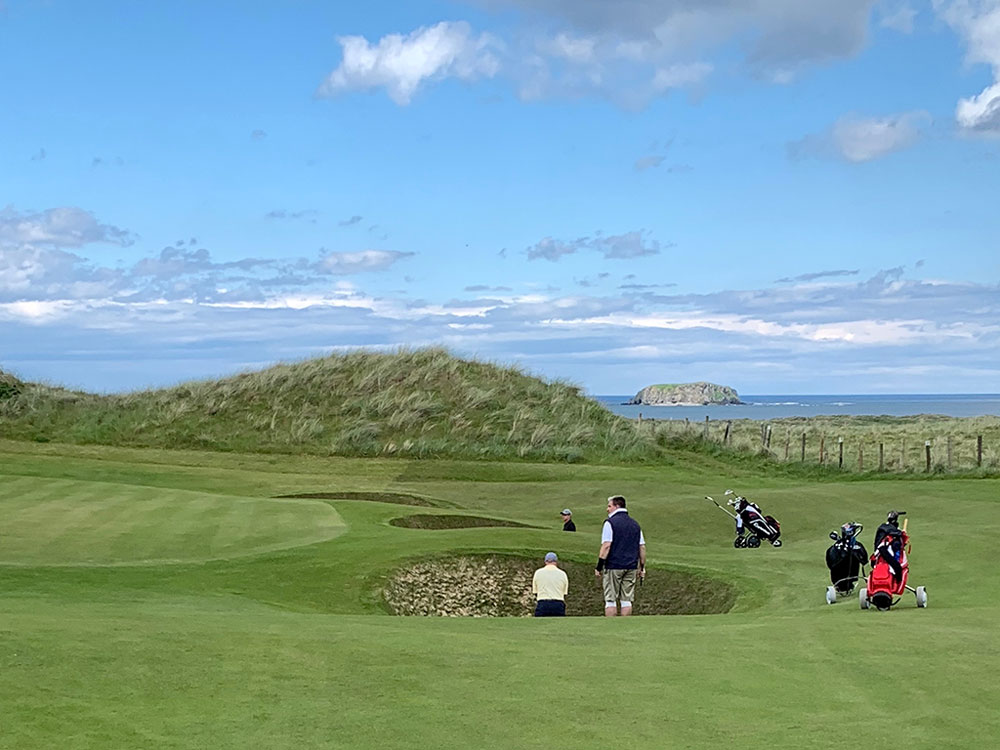
Somehow I feel deceived as I stand on the first tee of Ireland’s most northerly golf course, the renowned Ballyliffin Golf Club in County Donegal. Browntop bent grass that struggles daily to set its shallow roots on the sandy sea soil, to harsh for arable farming, seems lush today. The spiny leaved gorse, the definitive in unplayable hazards, is resplendent as the brilliance of a clear blue sky, the fertile emerald green of the nearby hillside form a picture-perfect backdrop for these yellow-flowering bane of golfers.
It is the cusp of summer where warmer weather becomes more reliable. My week of travel takes me to regions of Ireland and Scotland where the elements are a guesstimate, at best. It is the “four seasons in one hour” weather that makes links golf a true quest.
But today, on the Pat Ruddy/Tom Craddock design Glashedy Links the weather is perfect to showcase the site of the 2018 Irish Open. Completed in 1995, the course is considered “a little more difficult” than The Old Links Course but both should be experienced. Glashedy’s claim to fame, besides constant photo opportunities are the strategically placed bunkers: steep faced obstacles that can surpass the height of many a player and rough that one caddy once remarked, ” If the ball was wrapped in bacon, Lassie couldn’t find it!”
No bacon for me, but following my round a platter of haggis nachos at Ballyliffin’s Royal Hotel was delicious!
It is a brief sojourn to this most northerly of Irish courses and unfortunately my only stop in Ireland on my week of beautiful and natural golf experiences.

Golf in Scotland
Over the next five days I will experience five extraordinary designs that are championship in their makeup and reputation. Next stop, Scotland’s west coast’s Mull of Kintyre to play for the “worlds most natural course”, Machrihanish Dunes Golf Club. “Mach Dunes’ was crafted by David Mclay Kidd of Bandon Dunes fame opening in 2009, a perfect partner for Old Tom Morris’ original 1879 layout, Machrihanish Golf Club,
The Dunes follows the natural undulations of the land reducing the opportunities for a flat lie. “Shots down the middle” travel over contoured fairways as unseen steep walled bunkers lie in wait. The course’s yardage guide describes these disguised hazards as “audacious’.
Sheep can be spotted feasting on the generous fescue but even the most ambitious of appetites does not provide any simpler exit for a wayward performance. The first golf course constructed along Scotland’s west coast in one hundred years, it was worth the wait.
Sheep can be spotted feasting on the generous fescue but even the most ambitious of appetites does not provide any simpler exit for a wayward performance. The first golf course constructed along Scotland’s west coast in one hundred years, it was worth the wait.
Tomorrow we are off to the second-largest island of the Outer Hebrides, South Uist and the quaint village of Lochboisdale, one of the few remaining bastions of the Gaelic language.
Reminders of the historical significance of the land are evident everywhere. Thousand-year-old burial Cairns and standing stones provide a mysterious homage to ancient peoples. The island’s nature reserve showcases and protects its diverse plant and wildlife. But today we are off to play Askernish, to venture o’er the windswept dunes, as did Old Tom Morris when creating the course in 1891.
A “Wee” Challenge
Entering the small white “cabin-like” clubhouse an aroma of fresh baking and hearty soup is comforting on this windy, chilly day.
We arrange a wee challenge; to play Askernish with five clubs of one’s choosing. There is a great deal of discussion amongst our four-some on what clubs we will select. As I pull the clubs of my choice, a three-wood, five-iron, seven-iron, wedge and putter one of my playing partners discovers that in a back room there is a set of long ago used hickory-shafted clubs. I asked the resident manager if it would be possible to play these and he kindly agrees.

What better way to interact with a course, over one hundred years of age, with a set of clubs of similar vintage? I ask him to select five clubs for me. He chooses a brassie, a mid-mashie, mashie-niblick and inadvertently as I would find out attempting to tee off with what I thought was a cleek he had placed two putters in the ancient carry bag. Hitting off the same tees as my modern clubbed friends I played my round with four clubs finishing second, the most memorable day of golf I have ever experienced!
National Club Golfer stated that Askernish “is not your average golfing experience. For anyone with a love of links golf or an appreciation of the game’s rich history, it is a must-visit.”

Orkney Islands
Dawn has broken as we navigate the icy waters of Scapa Flow to set anchor off the largest town in the Orkney archipelago, Kirkwall. One hundred meters below lay reminders of Germany’s First World War navy. In 1919, the Fleet, waiting final terms of the Armistice, determined that it would not be decided in their best interest, within minutes, 52 of 74 warships were scuttled. These sheltered waters are a protected war grave for the British battleship HMS Royal Oak sunk by a loan German U-Boat, in 1939, with a loss of 834 sailors.
But today is a day away from golf; today is a day of exploration. For six hours we will travel the coastal roads exploring the rich history of this archipelago and passing by, sadly, the world-renowned whiskey distilleries of Scapa and Highland Park. With a population, less than ten thousand many of the residents of Kirkwall trace their heritage to Viking settlers. Five thousand years ago a prehistoric settlement was established, Skra Brae, now a UNESCO World Heritage Site the foundations of these domiciles still very evident. Along our journey, we stop to walk the paths encircling the Standing Stones of Sternness and Ring of Brodgar, considered the oldest of the “henge” sites. Constructed up to 3300 BC there are 1300 such locations recorded in the British Isles and Brittany.
Another stop at a makeshift, hand-painted Catholic church, built by Italian prisoners during the Second World War, then a leisurely walk along the neat avenues and harbour district of Kirkwall with a visit to St Magnus Cathedral founded by the Vikings in 1137, made for a very rewarding day.
Scotland’s Northern Highlands
A vast area, remotely populated, historic reminders of ancestral dwellings are never far away. Route 500 follows the rugged coastline while inland quaint villages in storybook settings are scattered amongst the hills and dales, home of Loch Ness, Scotch whisky and one of the world’s great golf meccas. Thirty notable courses many considered in the Top 100 Golf Courses in the World.
We are in Inverness where #53 Castle Stuart, site of many a Scottish Open, is less than fifteen minutes away. Constructed in 2009, it has always been on my must play list but my stay is limited so it is Royal Dornoch’s Championship Course where I tee it up.
International flags represent countries from around the world outspread with the northerly wind. These ceremonial arrays of colours acknowledge that I am standing on hallowed ground as the world’s third oldest golf club. Royal Dornoch is the most northerly of the thirty + “Royal” courses in Great Britain.
The Championship course {there is also the respected Strule Course] captures the raw beauty of the landscape, high dunes, thick gorse and panoramic vistas. Golf Digest recently ranked it the fifth best golf course in the world. Tom Watson once said Royal Dornoch was, “The most fun I have ever had playing golf”.
I wish I had space to describe the individuality that each hole possesses but there is one hole, the par 3 177 yard second that had me understand the penalties of missing the ‘over-turned saucer” greens. Following a par on the first hole, I thought that I was in a position for a birdie attempt. My ball hit the green pin high and my partners “high fived” my effort only to find, with a putter in hand’ that the ball had found a way to slide off the green resting 10 feet below in light rough. Two attempts with a 60-degree wedge to get it up, failed. On my fourth shot, the ball rolled to the other side of the green and two putts later I walk off with a triple bogey. It was comforting to know that Tom Watson had described the hole “as the hardest shot in golf”.
Our Last Day
It is difficult to believe that my trip has gone by so quickly! One more day and the members of our group make a friendly wager to be settled on a course, considered by many, as one of the world’s finest, Cruden Bay.
Located thirty minutes from Aberdeen the course is a myriad of enormous dunes, multiple elevation changes, panoramic views, blind shots, multi-leveled greens and fairways with a “four seasons in one hour “weather. Cruden Bay is twenty-seven holes of memorable championship golf. A “wee nip” of Cruden Bay whisky following our round is the perfect finish for my memorable week.
Weather was predictable in its unpredictability, the natural beauty of the journey will last my lifetime along with many new friendships.
Michael Cunningham/ November 19th, 2019









